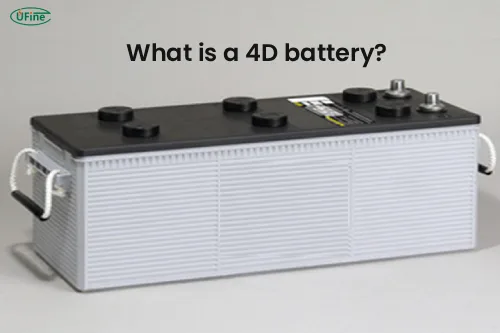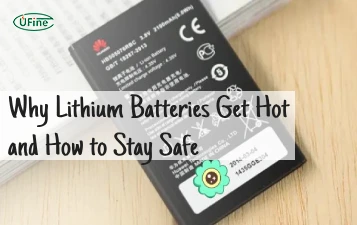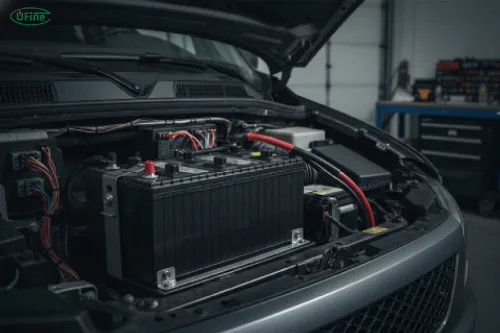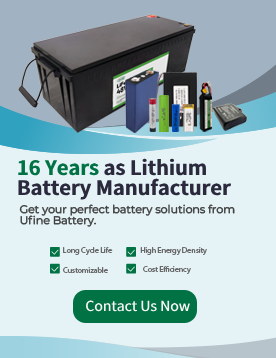
- Part 1. What exactly is a 4D battery?
- Part 2. How does a 4D battery work?
- Part 3. What are the standard size dimensions of a 4D battery?
- Part 4. How much does a 4D battery typically weigh?
- Part 5. What are the key specifications (specs) for 4D batteries?
- Part 6. What is a 4D battery AGM version and how is it different?
- Part 7. How long do 4D batteries last?
- Part 8. How to prolong the life of a 4D battery?
- Part 9. Group 4D Lithium Battery vs Lead-Acid Battery — Which is better?
- Part 10. What does a 4D battery cost and what price ranges should you expect?
- Part 11. Where can you buy a 4D battery (for example at Walmart)?
- Part 12. What should you know about the 4D battery box or packaging?
- Part 13. Conclusion
- Part 14.FAQs
Part 1. What exactly is a 4D battery?
Quick Answer: A 4D battery refers to a group size classification under the Battery Council International (BCI) standards. It is a large 12-volt battery typically used in heavy-duty vehicles, RVs, boats, and solar energy storage systems.
The term “Group 4D” mainly defines the physical size and capacity range of the battery, not its chemistry. Compared with the smaller Group 31 or larger Group 8D, the 4D offers a balance between power output and manageable size — making it popular in marine and off-grid applications.

4D batteries are designed to deliver high reserve capacity (RC) and cold cranking amps (CCA), suitable for both starting and deep-cycle applications.
Part 2. How does a 4D battery work?
A 4D battery works through electrochemical energy conversion. Inside the battery, lead plates (or lithium cells in newer models) react with an electrolyte to produce electrical energy.
For lead-acid versions, the chemical reaction between lead dioxide (positive plate), sponge lead (negative plate), and sulfuric acid (electrolyte) generates electrons during discharge and reverses the process during charging.
For AGM (Absorbent Glass Mat) models, the electrolyte is absorbed into a fiberglass mat separator, preventing spills and allowing better vibration resistance.
Newer lithium 4D replacements (typically LiFePO₄ chemistry) use lithium iron phosphate cathodes, offering higher energy efficiency, lighter weight, and longer cycle life.
Part 3. What are the standard size dimensions of a 4D battery?
The BCI standard size for a Group 4D battery is approximately:
| Parameter | Dimension (inches) | Dimension (mm) |
|---|---|---|
| Length | 20.75 | 527 |
| Width | 8.75 | 222 |
| Height | 9.88 | 251 |
Different brands may vary slightly (±0.1–0.3 inches).
Always verify your battery compartment or box before purchasing a replacement.
Part 4. How much does a 4D battery typically weigh?
Because of their large capacity, 4D batteries are heavy.
Typical weights include:
| Type | Example Model | Approx. Weight |
|---|---|---|
| Flooded Lead-acid | Interstate 4D-XHD | 117 lbs (53 kg) |
| AGM | Odyssey ODP-AGM4D | 132 lbs (60 kg) |
| Lithium (LiFePO₄) | Redway 4D LiFePO₄ | 57 lbs (26 kg) |
AGM VS Lithium VS Lead-Acid Battery: Comprehensive Comparison
AGM models weigh more because of denser lead plates, while lithium models can be up to 60% lighter.
Part 5. What are the key specifications (specs) for 4D batteries?
| Specification | Typical Range |
|---|---|
| Voltage | 12 V |
| Capacity | 150 – 200 Ah |
| Cold Cranking Amps (CCA) | 900 – 1100 |
| Reserve Capacity (RC) | 280 – 330 minutes |
| Terminal Type | SAE or Stud |
| Application | Starting / Deep-cycle |
These specifications make the 4D ideal for marine engines, solar storage, and backup power systems.
Part 6. What is a 4D battery AGM version and how is it different?
An AGM 4D battery is a type of VRLA (Valve-Regulated Lead-Acid) battery that uses glass-fiber mats to hold the electrolyte.
Key differences between AGM and Flooded types:
| Feature | Flooded Lead-acid | AGM 4D |
|---|---|---|
| Maintenance | Requires water refilling | Maintenance-free |
| Leak Risk | Possible | Sealed & spill-proof |
| Vibration Resistance | Moderate | Excellent |
| Mounting Orientation | Upright only | Any orientation |
| Cost | Lower | 20-30% higher |
| Typical Lifespan | 3–5 years | 5–8 years |
Because of their durability, AGM 4D batteries are often preferred in marine and off-grid systems.
Part 7. How long do 4D batteries last?
The lifespan of a 4D battery depends heavily on its chemistry, usage, and maintenance:
| Type | Average Lifespan |
|---|---|
| Flooded Lead-acid | 3–5 years |
| AGM | 5–8 years |
| Lithium (LiFePO₄) | 8–15 years |
According to the Battery Council International (BCI, 2023), batteries used in cyclic applications (like solar or RV) degrade faster due to frequent deep discharges. Proper charging and avoiding over-discharge can double battery life.
Part 8. How to prolong the life of a 4D battery?
Practical steps to extend battery lifespan include:
- Avoid deep discharges below 50% of total capacity.
- Recharge immediately after use to prevent sulfation.
- Keep terminals clean and tight to minimize resistance.
- Use a smart charger with temperature compensation.
- Store in moderate temperatures (15 – 25 °C / 59 – 77 °F).
- For AGM or lithium models, never use desulfation mode chargers designed for flooded batteries.
Part 9. Group 4D Lithium Battery vs Lead-Acid Battery — Which is better?
| Feature | Lead-acid (AGM/Flooded) | Lithium (LiFePO₄) |
|---|---|---|
| Weight | 110 – 130 lbs | 50 – 60 lbs |
| Energy Density | 35 Wh/kg | 120 Wh/kg |
| Cycle Life | 300 – 800 cycles | 3000 – 6000 cycles |
| Maintenance | Periodic (water/refill) | None |
| Discharge Depth | ≤ 50 % | 80–100 % |
| Price Range | $230 – $400 | $600 – $900 |
| Environmental Impact | Recyclable lead | Non-toxic lithium |
While lithium 4D replacements cost more upfront, they provide 3–5 times more cycles, lighter weight, and faster charging — ideal for RV or solar users seeking long-term efficiency.
Part 10. What does a 4D battery cost and what price ranges should you expect?
The price varies by brand, chemistry, and warranty:
| Type | Price Range (USD) | Example Brand |
|---|---|---|
| Flooded Lead-acid | $230 – $320 | Continental Battery |
| AGM | $300 – $450 | Odyssey, US Battery |
| Lithium | $600 – $900 | Battle Born, Redway Power |
Other factors that affect price: shipping cost, cold-cranking amps, and length of warranty (often 2–5 years).
Part 11. Where can you buy a 4D battery (for example at Walmart)?
Walmart offers several Group 4D models both online and in-store, mostly EverStart and Duracell AGM lines.
You can also find 4D batteries on:
- Amazon – Wider brand range, customer reviews, and fast shipping.
- Interstate Batteries dealers – For professional vehicle or boat installation.
- AutoZone & NAPA Auto Parts – In-store pickup and recycling programs.
When buying, always confirm:
- Terminal orientation (left vs right positive)
- Voltage compatibility (12 V)
- Warranty & core exchange requirements
Part 12. What should you know about the 4D battery box or packaging?
A 4D battery box protects the battery from vibration, water, and physical impact.
Key considerations:
- Internal size: must fit at least 21 in × 9 in × 10 in.
- Material: heavy-duty polypropylene or reinforced plastic.
- Features: vent holes, tie-down strap, carrying handles.
- Marine-grade boxes (e.g., NOCO HM408 or Attwood PowerGuard) offer extra corrosion resistance.
Using the correct box ensures safety, stability, and compliance with US Coast Guard or RV industry standards.
Part 13. Conclusion
The 4D battery remains one of the most versatile and powerful 12-volt solutions in the market.
From RVs and boats to solar systems, choosing the right size, chemistry, and maintenance plan can dramatically impact performance and longevity.
When comparing options, remember:
- Check dimensions and specs before purchase.
- Consider AGM or lithium for durability and maintenance-free use.
- Buy from trusted sources like Walmart or certified dealers.
- Always use a compatible battery box for safety.
With the right care, a quality 4D battery can serve you for 8–10 years or longer — powering your adventures and equipment reliably.
Part 14.FAQs
Can a 4D battery be used for solar energy storage?
Yes. Many off-grid and solar backup systems use Group 4D deep-cycle batteries because of their large capacity (typically 150–200 Ah). They can store substantial energy for overnight or cloudy-day usage. However, lithium 4D models are becoming more popular for solar systems due to higher efficiency and longer cycle life.
Is a 4D battery the same as a 4DLT or 8D battery?
No. Although similar in voltage (12 V), these are different BCI group sizes. 4DLT has a slightly different case shape and terminal layout, commonly used in agricultural equipment. 8D is larger and heavier, offering more capacity but requiring more installation space.
Can I replace a 4D lead-acid battery with a lithium version directly?
In most cases, yes — but check the charging voltage range and battery management system (BMS) compatibility. Lithium 4D replacements are drop-in ready for 12 V systems but should not be charged using an old lead-acid charger unless it supports a lithium mode.
How do I know if my 4D battery is bad or needs replacement?
- Engine cranks slowly or not at all.
- Voltage below 12.2 V even after charging.
- Swollen or leaking case.
- Excessive corrosion on terminals.
Use a load tester or multimeter to confirm capacity before disposal.
Are there maintenance-free 4D batteries available?
Yes. AGM and lithium 4D batteries are both maintenance-free options. They do not require adding water, and they resist vibration and leaks. These types are ideal for marine, RV, and solar setups where regular maintenance is inconvenient.
Related Tags:
More Articles

Why Lithium Batteries Get Hot — Causes, Risks, and Safety Tips
Find out why lithium batteries get hot, how to cool them safely, and ways to prevent overheating for better performance and safety.
100AH Golf Cart Battery Life: How Long Can It Last?
Wondering about your 100AH golf cart battery's lifespan? Find out what affects its longevity and how to keep it running longer. Read now!
What Is a Battery Disconnect and Why You Should Use One?
Learn how a battery disconnect switch prevents power loss, improves safety, and extends battery life for cars, RVs, boats, and solar systems.
Do Car Battery Testers Really Work Accurately?
Discover how car battery testers work, their accuracy levels, and which type gives the most reliable results for your vehicle.
Why Do Batteries Get Sulfated and How Can You Prevent It?
Learn what causes sulfated car batteries, how to fix them with desulfation charging, and expert tips to prevent future battery damage and failure.





